
A cast from the past.
Toys aren't made in a cultural vacuum. They reflect the historic context in which they're created.
Frequently it's easy to guess the decade in which a toy was produced. My previous blogs, Wood Toy Fire Truck Fragment, Red Folk-Art Caboose, and Garland Red Flyer Toy Fragment also talk about toys as time-capsules.
It's my observation that as the roaring '20s were becoming much less roaring, the size of toys grew smaller and smaller.
My US Motor Unit is only three inches long, a diminutive art-deco toy. The characteristics that date this little gem to pre-World War II are that it is a slush-cast metal toy with rubber wheels. Both metal and rubber were rationed after the Japanese attacked Pearl Harbor.


This little gem was made by Barclay Manufacturing Company in North Bergen, New Jersey. The factory derived its name from a street in Hoboken. Go figure. Barclay was just one of many manufacturers producing metal toys for the new middle class created by the economic boom after World War I. In Barclay's heyday, the company cranked out half a million toys a week.
If you would like a partial list of toy manufacturers, you can go to these two links and get bored to tears. Unless, of course, toys are your passion.
http://www.antiquetoys.com/resources/toy-makers-a-j/
http://www.antiquetoys.com/resources/toy-makers-k-z/
Now onto the topic of slush casting. Yes, it's really a thing. No, I didn't know about it either, until I started this blog.
The important characteristic of slush casting is that it is hollow. Using this process, the manufacturer could produce toys much less expensively than through other casting methods. It might not be as strong as other methods, but who cares? It's a toy.
If you'd like to know more about slush casting (than I ever care to) please cast your eyes upon this website.
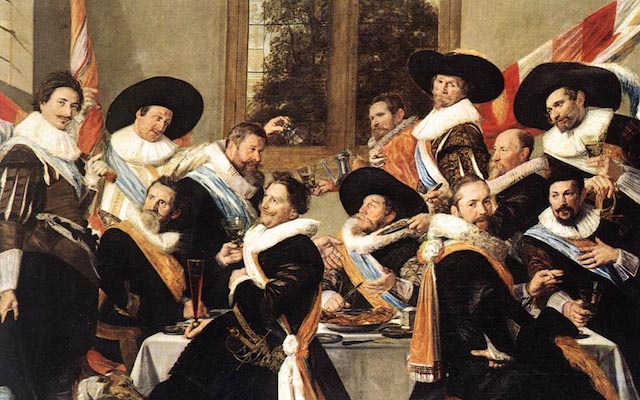
Frans Hals: Banquet of the Officers of the St George Civic Guard Company (1627)
With Frans like These, Who Needs Enemies?
In an earlier blog post, “Honest Mistakes and Audacious Lies,” I quoted a New York Times article about incredible fakes in the world of “period furniture.” Once again, the professionals in the highest echelons of the art world have found themselves in a pickle.
Frans Hals’ Portrait of a Man, authenticated by Sotheby's and the Louvre and subsequently brokered to a private collector for about $10 million, has now been declared a modern forgery.
In fact, according to the New York Times, the fake is so good that other “new discoveries” sold by the same art dealer are now being questioned, while an eminent Dutch restorer of Hals’ paintings refuses to accept that Portrait of a Man is a fake. This is a major scandal in the art world.
To wish harm or embarrassment on the Louvre or Sotheby's is not the intent of this blog; rather my goal is to point out the intense challenges art experts face by the pluck and (dare I say it?) talent of master forgers.
When a Dutch restorer of nearly 30 of Hals’ works cannot tell a forgery from the real thing, it undermines the whole business of authenticating “new discoveries” of old masters.
Sotheby's is now publicly traded; reimbursement of the buyer's millions is only the beginning of the challenges the auction house faces as it tries to restore its reputation.
And fooling the Louvre? Oh, mon dieu!
For further reading on the art market see this article from Fortune Magazine
Image credit: The Athenaeum

Image from Smithsonian National Air and Space Museum
DC-3 Stewardess Cart
The Douglas DC-3 airliner is very dear to my heart. I have loved the design and romance of this plane from my childhood, so you can imagine my excitement when a dear friend called and asked me if I would like to accompany her on the final flight of United Airlines’ retiring DC-3 fleet. The year was 1968. The flight was round-trip between San Francisco and Santa Barbara.
Truly a once-in-a-lifetime opportunity.
My friend was, at the time, the longest serving stewardess at United Airlines. She began her career in 1936 serving aboard United’s Douglas DC-3 Sleeper Transports, also known as Skysleepers, from San Francisco to Honolulu. She had to be on that last flight and she invited me to join her.
Here's a photo of passengers boarding a DC-3 in the early years, from the Smithsonian Air and Space Museum.
Flash forward to the year 1999. My husband was a book editor. When a colleague, in a pinch, asked him to ghostwrite a few pages of a workbook based on a best-selling self-help book (which shall be nameless), he panicked. But since I happen to have once been addicted to the self-help genre, I told him, "Don't sweat the small stuff. We'll work on it together. It'll be fun." Besides, we were being paid a tidy sum for a few hours work.
A few weeks later we were out poking around antique and vintage shops. We wandered into a shop called Futures on Granby Street in Norfolk, VA. Much to my surprise and delight, we discovered an extruded aluminum and Bakelite airline serving cart from a DC-3. Wow!

We just had to have this classic example of industrial design. Bonus that it served on a DC-3. And the price was exactly what we'd been paid for our work on the book. Self-help indeed!
Click here if you'd like more information about the DC-3.
Here are more links that demonstrate the DC-3's stature as an icon of art deco industrial design.
Video of Delta Airlines' restored DC-3 ship 41.
Video of restored DC-3 on flight from Orlando to Punta Gorda.
Swissair’s restored DC-3.
Image credit: Smithsonian National Air and Space Museum
Digging up Childhood Memories
As I've so often said, I'm addicted to industrial equipment romanticized as children’s toys. This glorious steam shovel is yet another example.
Though it's a little different, this toy resembles Mary Anne, the heroine of the classic book, Mike Mulligan and His Steam Shovel. The story, written and illustrated by Virginia Lee Burton and first published in 1939, is worth a read or re-read.
Much as Little Toot celebrated tug boats, and The Little Engine that Could preached perseverance through positive thinking, Mike Mulligan and his steam shovel, Mary Anne, also glorified the mechanical workhorses of the time. All three books were written or became popular in the 1930s. All are still popular today. What's particularly poignant about Mike Mulligan and His Steam Shovel, is that Mary Anne is already a relic – made obsolete by gas and diesel-powered shovels. It's up to Mike Mulligan to prove Mary Anne (and Mike himself) is still relevant in a rapidly changing world.
In 1990 HBO aired Michael Sporn’s faithful adaption of Mary Anne’s sweet story: https://www.youtube.com/watch?v=KZtXtbZn5f0
Or watch this charming amateur stop-action version: https://www.youtube.com/watch?v=K3wTj-0pMwY&t=198s#
And, of course, you can check out the book from your local library or buy it here »
Or here »
Or here »
As I mentioned, my toy steam shovel is a near perfect representation of Mary Anne except that mine is a riding model. So I can pretend she's Mary Anne's sister.
It is surmised that Mary Anne was named after the Marion Steam Shovel Company, founded in Marion, Ohio by G.W. King in 1884. These links to the U.S. Park Service and the Ohio Historical Society provide wonderful visuals and factual information about the company.
While I was researching this blog I came across an article regarding Fred Lundahl, the founder of Buddy L toys. It includes a photo of his son (nicknamed Buddy L.), playing with a steam shovel very similar to mine.
My virtually complete, rusted steam shovel was made by the Buddy L Toy company around 1926. Click here for a photo from the Smithsonian’s collection which shows a Buddy L Steam Shovel in excellent condition.

The Buddy L Toy Company started out as the Moline Pressed Steel Company. It fabricated bumpers, door panels, etc., for auto and truck manufacturers. As the story goes, Mr. Lundahl was appalled at the poor quality of toys available for his son to play with. On a whim he made a truck for his son, and soon all the other kids in the neighborhood wanted one.
In 1921 he made a few more trucks and car prototypes and off he went to a toy show in New York. The response was so overwhelming he retooled his shop to make stamped steel toys under the name Buddy L Toy Company in honor of his son.
I couldn't find a reference documenting any correspondence between the Marion Steam Shovel Company and Buddy L, but I wouldn't be surprised if these two companies collaborated on the toy version of Marion’s steam shovels.
Here are a few more photos of toy steam shovels:
I hope you dig them as much as I do.
Turkish Delight
On January 3rd the mail brought a fresh batch of consumer lifestyle catalogues to my door. I am fascinated by trending color palettes and the romantic names that sellers give to their merchandise.
Pottery Barn was the first to arrive in the New Year. Thumbing through the catalogue, I was impressed by the evocative names they gave to their home furnishings.
Murano: a series of islands in the Venetian Lagoon
Malta: an island republic in the Mediterranean Sea closely associated with the Knights Templar
Dara: a female/male name used in southeast Asia, meaning "star"; in Hebrew "compassion" or "wisdom"; in Punjabi "leader" and in Persian "wealthy"
Shibori: a Japanese method of dying cloth
Lucca: a city in Tuscany, Italy
Iznik: a town in Turkey; the name of the pottery produced there in the 15th, 16th and 17th centuries
Sophia: a Greek female name meaning "wisdom"; in Istanbul Hagia Sophia ("holy wisdom") is a massive church built in the 6th century
Constantinople: one of the historic names for current day Istanbul. Over the ages it has also been called Lygos and Augusta Antonina, but the historic name most associated with the romance of the east is Byzantium
The historic significance of these last three names, Iznik, (Hagia) Sophia, and Constantinople, are bound together in my experience.
One afternoon in 2008, work in our studio was interrupted by a young man selling Iznik (whatever that was). He had his much older father in tow. Both gentleman spoke English with a heavy accent.
As it turned out they were Turkish nationals, the young man a student at NYU and the father was in the U.S. to help him sell Iznik to assist in paying for his education.
They had been trouping from shop to shop and design firm to design firm essentially trying to sell their wares door to door unannounced. Not a good idea for them… until they stumbled into our studio. We were so impressed with their earnestness that we said, "Sure! Show us what you've got." We had no idea what to expect, but those expectations weren't high.
The men disappeared out to their old, white van and unloaded into our conference room a dozen or more of the most magnificent ceramic Iznik plates. We were amazed at the beauty, subtlety and delicateness of these pieces.
The man and his son had introduced us to the world of the high Ottoman art of Iznik ceramics. Iznik potters created the tiles that adorn many of the mosques and palaces of the Ottoman Empire.
We purchased all the pieces they had in their truck and many more over the years. Eventually, we traveled to Istanbul to meet the family and to tour Hagia Sophia, Topkapi Palace museum and many of Istanbul’s mosques.
The photograph of the blue and white plate that introduces this blog is an example of the contemporary Iznik pottery we purchased from them. This particular plate hangs in my home. It is my understanding that this pattern was originally produced by Iznik potters between 1480 and 1520.
Now back to the Pottery Barn catalogue: You can see why I found "Iznik Vases" with traditional Iznik-style floral patterns fascinating. Just as our Turkish friends introduced Iznik to us, PB was casually introducing the American consumer to Ottoman-esque art. At the very least PB used the term Iznik, so anyone could Google it and find a world of fine art.
Here are some links and references if you'd like to learn more about Iznik:
Iznik, The Pottery of Ottoman Turkey by Nurhan Atasoy & Julian Raby
The Art of the Islamic Tile by Gerard Degeorge and Yves Porter
Iznik, the Artistry of Ottoman Ceramics by Walter B. Denny
http://www.turkishculture.org/ceramic-art-582.htm
http://www.turkishculture.org/ceramic-arts/tiles-and-ceramics/ottoman-ceramics-301.htm?type=1
http://courtauld.ac.uk/gallery/what-on/exhibitions-displays/illuminating-objects/iznik-dish
http://www.nytimes.com/1998/05/29/arts/antiques-iznik-wares-even-rarer-than-ming.html
http://www.iznikclassics.com/en/content/history-iznik-around-the-world-s74
As side note to this blog I would like to share an additional aspect of high Ottoman art: Ipek, the silks of the Ottoman court.
As so often happens with ideas, one leads to another. A few years ago the Arthur M. Sackler Gallery at the Smithsonian had an exhibit of Ottoman silks, which I could not pass up. After seeing this stunning exhibit I had to purchase – and highly recommend – the exhibit catalog:
Ipek - The Cresent and the Rose, Imperial Ottoman Silks and Velvets by Nurham Atasoy, Walter B. Denny, Louise W. Mackie, Hulya Tezcan
http://topkapisarayi.gov.tr/en/content/sultan-caftans-fabrics-carpets-and-sacred-coverings
May your own mail-order catalog adventures carry you far.
Holland’s Hidden Hooch
We were out picking when we saw an entire series of miniature Blue Delft pottery houses, each approximately four inches tall. From our travels in Holland we knew these houses had to have something to do with Dutch canal architecture.
We carefully picked one up and looked on the bottom: “Blue Delft exclusively made for KLM by Bols Royal Distiller Holland.” On the back appeared "Bols," along with the KLM logo and the number 41. There was also a sticker that read, “Empty due to customs regulations on this route."
Apparently these were charming little liquor bottles. That was enough to fire my imagination.
The dealer told us he had found the entire collection – scores of tiny Dutch buildings – at a single estate sale. He professed he had no information other than what was on the bottles.
Some dealers like to share the romance of an object and others don’t. We found the houses/bottles so compelling, we purchased a dozen or so; half were still corked and sealed across the chimney/spout.
It turns out that these Blue Delft houses had been presented to business class passengers on Koninklijke Luchtvaart Maatschappij; aka KLM Royal Dutch Airlines, from the mid-1950s to the mid-1990s.
Many of the miniatures, modeled after actual Dutch buildings, contain (or contained) a Dutch liquor called Genever, or at least they did until 1995. After that, newer, empty bottles were made available. KLM releases a new one every year on October 7. They've come out with almost 100 miniatures so far. Each is numbered. There's lots of controversy among collectors regarding which numbered houses are more valuable. If you would like to know more about these little bottles, you can begin at this website or at KLM's own site. If you are obsessed with them you can Google "KLM Houses" and find plenty to read.
The story of KLM embodies the romance of air travel. Founded on the 7th of October, 1919, it was the first commercial airline, with many pioneering firsts to its credit. If you have an interest in such things you can begin your search at the KLM website.
And if you love Dutch canal architecture enough to want it in your home or office, you can purchase a mural from Numer Art. The image is not on their website and I cannot reproduce it here because of copyright issues but they would love to answer your inquiry.
Proost!
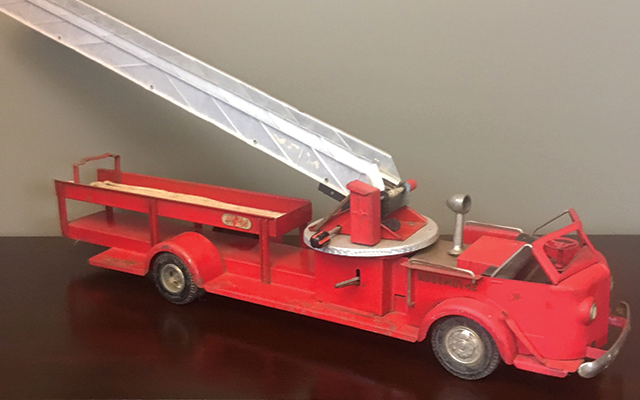
An American Toy Icon
Once again we have acquired an iconic American toy in a very unusual fashion.
A good friend was eager for us to see his new home prior to the closing. As friends and interior designers, we were eager to see it – every nook and cranny. The seller had virtually moved out with the exception of a few pieces of furniture and framed posters.
The room over the garage was entirely empty except the owners had left behind a toy fire truck, which we swooned over. When our friend asked the seller's agent if it was for sale, she quoted a ridiculously low price. But once the owner realized someone had expressed an interest in it, the price grew fourfold.
We had to laugh. All too often, people couldn't care less about something until someone else shows an interest. No worries; we still were willing to buy the truck.
We never intend to pay less than an item is worth, but we seldom have any idea what something is worth until we have a chance to do our research. On the other hand, experience has taught us that if you don't buy something when you see it, it'll be gone when you go back for it. (As buyers we hate when that happens; as retailers it gives us secret joy. Folks: if you see something you like – buy it and make yourself and a shopkeeper happy!)
We're as prone as anyone to purchase emotionally. The vintage and antique objects we buy don't really have a market value. The real estate business has a great term that describes the true measure of value: "A ready, willing and able buyer and a ready, willing and able seller.” A thing is worth only as much as someone's willing to pay for it.
This reminds me of something my friend, the late Ed Bridgeforth, III, told me regarding the value of things and ideas. He said he had a fantastic business giving $5,000-an-hour breakfast talks to anyone who would pay to listen. He joked that it was a brilliant business model. No overhead, just show up and talk and collect the check. The only downside was that no one wanted to pay him that much to hear what he had to say.
The point he was making is that nothing has value unless someone wants to purchase it. And good luck finding that person. So whatever journey you're on, it had better give you satisfaction because that may very well be all you get.
But I digress. This blog is about the toy fire truck. From previous blogs you know I like toys and love trucks.
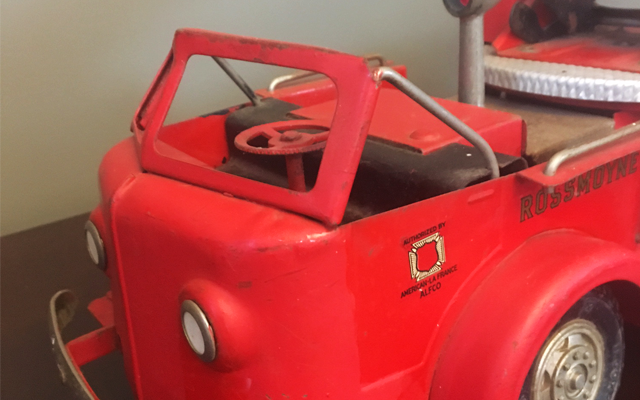
In 1950 the Charles Wm. Doepke Co. of Rossmoyne, Ohio, changed its toy line and introduced a realistic replica of the American La France aerial ladder fire engine.
And what a magnificent toy fire engine it is: 1/16th scale of the actual American La France aerial ladder truck used by fire companies to save countless lives all over the United States.
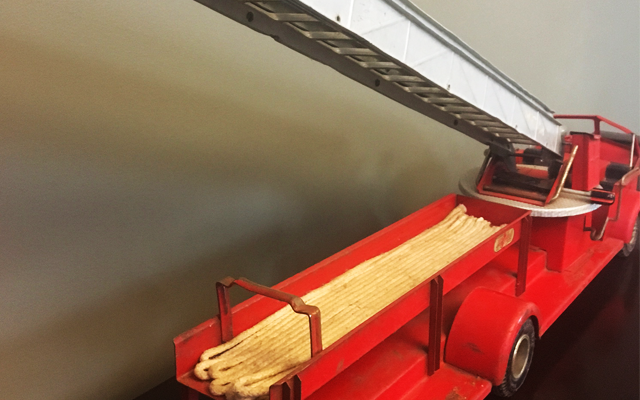
The classic toy model #2008 had:
I had never really seen anything like it before.
The truck we found was missing a few parts, but it also included hoses coiled on the platform below the extension ladder. These actually look and feel real. I couldn't find a single reference to the hoses anywhere, including on The National Fire Heritage Center web page concerning the restoration of the American La France.

Doepke produced these high quality toy fire engines until 1959, when they could no longer compete with the toys made of cheaper quality steel.
Please let me know if I have made any factual errors or you have any additional information on the American La France.
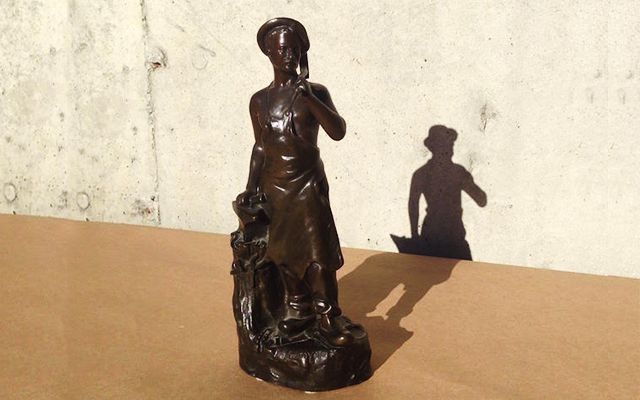
Siegfried Bing’s Influence on Bronze Sculpture
We usually begin our European buying trips in Amsterdam. What a marvelous walking city, full of art, culture, good food, amazing museums, lovely people and surprises.
We never research what's happening before we go because our trips always involve either our design practice, antiques business or Color Marketing’s European meetings.
Our trip in the autumn of 2004 was especially memorable because the van Gogh Museum was presenting an amazing exhibit on Siegfried Bing and his Maison de l’Art Nouveau (House of New Art).
Bing was the sole founder and creator of the style we know as Art Nouveau. He was a Franco-German art dealer specializing in Japanese art who bounced from Berlin to Paris.
Around 1890 he had an epiphany: Art should be a way of life incorporating architecture, furniture, fine art, decorative art, jewelry, sculpture and lighting. He designed and built a new gallery, Maison de l’Art Nouveau, in Paris, for the specific purpose of showcasing his new philosophy and the works of artists and artisans who aspired to it.
The most recognizable adherent to Bing’s style in the United States was Louis Comfort Tiffany, the founder of Tiffany and Company. L.C. Tiffany embraced Bing’s new art by creating magnificent objects, the most recognizable examples being the stained glass lamps and windows that bear his name.
At the Amsterdam exhibit, what moved me the most was Bing’s influence on bronze sculpture. Here was fine art in which the working class was represented with dignity, beauty and respect.
There were bronzes of dock workers, miners, blacksmiths, construction workers and farm workers, including women. I was dumbfounded by the grace and presence of these figures.
In our travels and picking we have only seen three similar items for sale. One was in an antiques shop in SoHo, one was at the Baltimore Art and Antique Show, and the third one we actually found in Virginia Beach. We acquired all three; placed one in a client’s home and kept the other two.
Here's how we found the bronze blacksmith sculpture at the Baltimore Art and Antique Show:
As we were finishing up our review of the exhibits, I noticed a small bronze on a back shelf of a booth near the door. We entered the booth, smiled at the dealer and asked if we could examine the sculpture. It was signed "Gamboge" or "Jamboge" and not the quality of the sculpture in the Bing exhibit, but certainly a fine representation of the bronzes we had seen there, and probably dating to the late 19th century. On the base the artist had inscribed, "In Labor Virtus."
It was not priced, so we knew we probably couldn't afford it.
The dealer asked us if we knew anything about it. We shared with him our experience at the van Gogh Museum. He admitted that he had been dragging the bronze from show to show and we were the first people who had any interest in it, let alone an inkling about what it was.
I set it down and thanked him for allowing us to examine it. As we were exiting his booth he asked if we would like to purchase it. We smiled and shrugged and out of his mouth came a ridiculously reasonable price; he said he was tired of dragging it around.
I took it home, gently cleaned and waxed it, and now the art nouveau blacksmith sits on an etched glass table in our Vermont home. (I’ll share the story of the acquisition of the third sculpture in an upcoming blog post.)
Each trip brings surprises, inspiration and a new cultural experience. That is why we travel. Please feel free to share your experiences with me.
An Aboriginal Original
As pickers, we drive a large, gray Sprinter van up and down the Atlantic states. When we pull in to our shop in Brandon, Vermont, everyone in the village – as well as people driving along Route 7 – can see the truck and know we're back with another load.
I was going to write that it's like the Wells Fargo wagon coming to town. But, alas, that once quaintly wholesome reference is now irredeemable in light of recent events.
Suffice to say the Sprinter draws folks into our antique shop to see our latest finds. And sometimes people approach us with items they want us to buy. Such was the case with Robert S., who showed up with a magnificent "returning" boomerang. Its color, patina, texture and supple curving lines captivated us.
An aside: We have found that many lovely "ethnic" objects were traded only after they've lost their usefulness or developed bad juju. We have acquired many such objects over the years…but so far no bad juju.
We know nothing about boomerangs, but to our admittedly untrained eye the craftsmanship, weight and chipping marks suggested it was made by an Aborigine for his own use. But again -- what do we know?
Robert told us it was given to him in 1956 by Burt H. A silk salesman between the wars, Burt traveled on steamships, plying his silks throughout the English-speaking world. He acquired this marvelous specimen on a trip to Australia around 1925.
Everyone knows what a boomerang is, right? Yes and no.
There are "one way" boomerangs, called kylies, developed around 9,000 years ago, and used:
Then there are "returning" boomerangs, such as the specimen we acquired, which are used in marshes to frighten birds into waiting nets. These boomerangs are only a few hundred years old, and make up only a small percentage of Aboriginal boomerangs. Generally they are:
We love when a Found Object like this finds us and provides the opportunity to learn something new.
Oh yes, we purchased the boomerang from Robert. Thank you, Robert!

Above and Beyond
You can never gauge a company's integrity until something goes wrong. How the business handles a problem tells you everything you need to know about it.
In this blog post I'm digressing from my usual Found Objects topics. Instead, I'm writing this as the president of Details Interior Design, to thank three companies that have provided our design practice and our clients with exemplary customer service.
They are:
How many times have we contacted a company about a product's performance, only to be told, "Sorry, that's no longer under warranty" or, “It's X’s fault for the failure, and not a problem with our product"?
In our design practice, and also in our private lives, we hear these familiar refrains because so many suppliers find it easier to look for a way out rather than to strive for meaningful resolution.
The three companies listed here understand that customer service is about more than serving customers. It's also about building relationships.
As designers and specifiers, Details Interior Design is a service company. We live or die by whether our clients are happy with the service we provide. And, to an extent, that level of service depends on the integrity of the suppliers we use. Sure, sometimes the client might have unrealistic expectations, or a problem might fall under the realm of the general contractor, but at other times a client might have a legitimate complaint about the performance of an item we specified.
By providing excellent customer service, the three companies listed here go the extra mile to protect their reputation and Details Interior Design’s reputation, sometimes long after the sale.
On behalf of our clients and the Details team, we thank these businesses for the care and respect they have granted us.
Best Wishes.
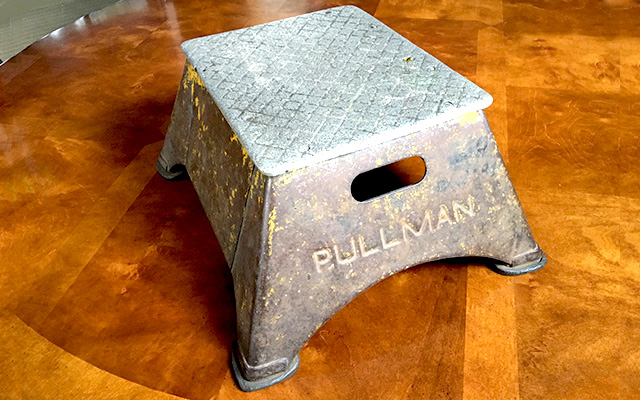
Iconic Pullman Stepstool
In honor of the opening of the Smithsonian’s National Museum of African American History and Culture, this blog post is about the little known influence of railroad Pullman porters on hastening the demise of the Jim Crow laws in the South.
The South has historically been a repressive and unfriendly region to African Americans, unless of course the white population required menial laborers, cotton mill workers, domestic help, etc.
The region went so far as to legally ban African American newspapers published in the North from being sold in the South. One such highly influential paper was the Chicago Defender. (From 1956-2003 it was called the Chicago Daily Defender.)
It was understandable why segregationists did not want The Defender circulating below the Mason-Dixon line. It was the prime source of information regarding the horrible extent of lynching and the gross injustice of Jim Crow. And yet, thanks indirectly to the Pullman Company, the banned paper reached its Southern audience.
The first class sleeper cars of the Pullman Company served the wealthy elite in trains throughout the entire United States. With yellow Pullman stepstools in hand, the porters – always African American – would help these passengers board and exit the train. Many porters would pick up copies of the Defender when the train traveled north, and distribute them at stations in the south.
The yellow stepstool became a symbol of the Pullman porters' influence.
Once again we were in a rural junk shop in Vermont looking for the rare find and – lo and behold – a Pullman stepstool, with the remains of its original paint and the name Pullman on the side. It was in the back of a barn and covered in grease and grime. But it was clearly Pullman and I had to have it. Wow, I paid far too much for it but I could not pass it up.
To be honest with you, I was not aware of its historic significance until recently. I am pleased to honor the dignity, industry and fortitude of these hardworking Pullman porters.
Finding Folk Art
Last fall we visited a town on the Rappahannock River in eastern Virginia; a friend had arranged for us to meet a gentleman there who was said to collect good stuff.
That was an understatement. This fellow had an amazing collection of, well, nearly everything. He had collected early 20th century cigar forms, 19th century folk art, lamps, advertising relics, early Chinese building fragments, French garden furniture and industrial tables. He was a picker's dream come true.
But the surprise find of the day was this collection of folk art toys. If you went searching for a collection like this you would never find it; it almost has to find you. And we're glad this collection found us.
On a shelf above the back door, covered in dust, the toys seemed to have been forgotten. As we were leaving I looked up and commented on them.

The gentleman said he had not thought about them in years and – astonishingly – said if we wanted them we could have them. Well, yes please! Then he excused himself and returned a few moments later from the garage with two more boxes of toys.
The collection was created by K.G. Worrell, using scraps of wood, wire and metal. He left virtually no detail wanting.
This past week we pulled the boxes out of our storage and inventoried, cleaned and photographed the entire collection.
Here are some photos so you can enjoy them, too.
As seen on TV!
Sometimes an object can be so unabashedly, so unselfconsciously, and so deliciously tacky, that its tackiness becomes its most endearing feature. That is the soul of kitsch.
The problem with the term is that it's often wrapped up with class connotations. Today's kitschy treasure was yesterday's un-ironic symbol of a striving lower middle class. Some of kitsch's power comes from our knowledge that, once upon a time, somebody actually liked this stuff! True kitsch is a monument to someone else's lack of refinement. So we chuckle at it. And that's okay. But let's not forget that behind every piece of kitsch lies a more personal story.
My maternal grandmother, Gladys, had a black panther lamp crouching on the top of her television set until she passed away at 94. She certainly wasn't the only one with a lamp like this. It was marketed as a TV lamp, because it supposedly wasn't good to watch television in the dark. I can remember seeing the panther on her set from the 50’s through the late 80’s.
I always hated it but loved it at the same time; when she passed away, no one in the family wanted the lamp because it was so tacky. Except me.
It now sits on the top of my early 19th Century, English pine chest of drawers in a place of honor. I love it because it's so awful, and also because it reminds me an awful lot of Gladys.
Gladys Schisser began working for the Denver and Rio Grande railroad in 1918, cleaning Pullman cars for the very wealthy.
She lived in a boarding house, saving her money. With the help of the railroad union she purchased her home feme sole, meaning she was an unwed, single woman. She also had two young daughters. Scandalous for the time.
She retired from the D&RG in 1959, a proud, unbending woman of the West. She passed away in her home.
Yes, my grandmother was a member of the working class who loved her black panther TV light. Here's a woman who, through sheer force of will, carved a life for herself. And if she wanted to indulge by buying a stylish lamp for her TV, well, she damn well earned the right to.
I am proud to own it and happy to call it kitschy. Because -- let's face it -- it's kitschy! Thanks Gladys.
Now you can see why I was so delighted to find a chartreuse panther TV lamp. You seldom see them in any color other than black, so when we found this bright green gem I figured it was a cheap, modern reproduction.
But it's the real thing. No chips, no cracks, and the light still shines. I wonder where it's been all this time.
I call it The Big Fun Kitschy Chartreuse Panther TV Set Light, or the BFKCP TV SL.

Mauve emerges from the muck
Prior to 1856 all the colors used in everything were derived from plants, minerals or animals. Back then, your local Sherwin Williams or Benjamin Moore paint stores would have been terribly uninspiring.
So where'd all the color come from?
In May, 1856, William Henry Perkins, an 18-year-old British chemistry student, was working in a lab, trying to create artificial quinine from coal tar. At that time quinine was the only known treatment for malaria, and it was derived from the expensive bark of the cinchona tree. By 1836 the British Empire was consuming 700 tons of cinchona bark annually.
A formula for synthetic quinine would be of great value. However, all of Perkins' experiments ended in disappointment.
After the conclusion of yet another exasperating failure, as he was discarding the resulting sludge, he realized it was a brilliant purplish color.
He had inadvertently created the first synthetic, chemical dye, mauve.
Perkins' happy accident advanced the field of chemistry and became the foundation of today's seemingly endless palette of colors.
Meanwhile, the invention of synthetic quinine would take almost another 100 years.
Moving in place
This toy fragment is a beautiful example of streamlining -- a design element of the late art deco movement whose curving forms celebrate motion and speed.
World War II interrupted the influence of streamlining, but as soon as the war ended the style was revived, extending well into the 50’s. I love seeing these deco elements used on toys; it gives everyone a chance to enjoy the vibrant streamlined era.
All that remains of this toy are its pressed steel body, four metal tires and its aged, original red paint job. Once it was a riding toy dump-truck with a handle, seat and hydraulic dumping mechanism. Later versions had rubber tires.
Its manufacturer is a mystery. Some call it Boy Craft Garland; some call it the Garland Red Flyer. The closest I can come is the Garland Stove Company in Detroit. We found it in a junk shop in upstate New York and were tickled to see that it had survived the ravages of time and hard use.
We hope you enjoy streamlining’s stylish sense of motion as much as we do.
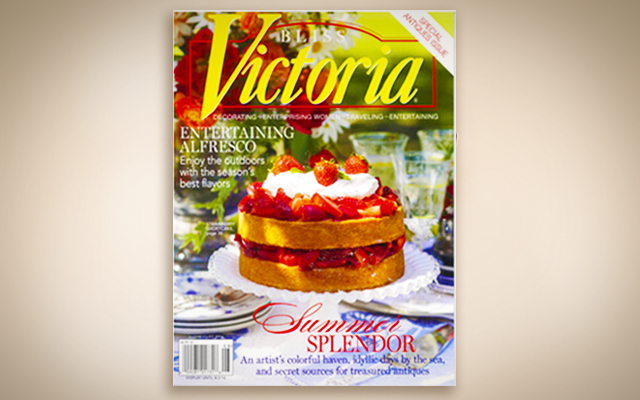
An Artist’s Abode
Brandon, the little town in Vermont we call home, is known for its community of artists and has been called “The Art and Soul of Vermont.”
Ms. Judith Reilly, one of Brandon’s artists, was featured in the July/August issue of Victoria magazine. We are very proud of Judy. You go, girl!!!!
Please click on the link and enjoy the article here »
You can also visit Judy’s website here »
Please visit the Brandon Artists Guild’s website to see what many of Brandon’s other artists are up to.
And if you’re interested in life in our artsy and historic little village, please click here »
Enjoy!
Pivoting Pachyderm
On August the 23rd, 2011 at 1:51 p.m., I was standing in the lobby of our design studio when our 25-pound, bronze Meiji-period elephant sculpture began rocking forward and back as if it had come alive. And indeed it had: at that exact moment a magnitude 5.8 earthquake struck outside Washington, DC and rocked our elephant in Virginia Beach.
Why did this pivoting pachyderm rock back and forth rather than sideways, or simply fall over?
Because he was designed to represent an Asian bull elephant in full charge: his right front leg and left rear leg extended; as in life, his weight perfectly balanced between raised trunk and pointed tail. He’s a marvelous example of Japanese Meiji craftsmanship and bronze casting.
From 1178 AD to November 9, 1867 AD the Samurai Shogun warlords ruled Japan. The role of Mikado/Emperor was never abolished but had been reduced to nothing more than a figurehead under the Shogun’s authority. On that November day the last Shogun, Tokugawa Yoshinobu, tendered his resignation to the reigning Mikado, the 14-year-old Mutsuhito, the 122nd Mikado of the Chrysanthemum Throne.
The Japanese imperial restoration occurred on January 3, 1868 and with it came the dawn of modern Japan. Mikado Mutsuhito renamed his throne Meiji -- Enlightened Rule -- to honor the reinstatement of the Mikado as Japan’s legitimate ruler. Mutsuhito ruled for 44 years.
For many centuries the Samurai warriors fought in the most magnificent armor; wielding swords, bows and arrows, and lances created in the workshops of renowned artisans.
These weapons of war were as much fine art as killing tools. When the Samurai period ended, these artisans found little demand for their skills. However, 14 years prior to Tokugawa Yoshinobu’s resignation, Commodore Matthew C. Perry, USN, inadvertently supplied these workshops with the economic impetus to continue their craftsmanship.
His flotilla of four American warships forced Japan to open its economy to trade with the United States and Europe, ending centuries of isolation and giving the artisans access to the West’s rising demand for exotic Eastern luxury objects.
Our Meiji-period bronze elephant is a result of this tradition, dating back to the 12th Century AD.
We acquired it at Prozzo Auction House in Rutland, Vermont. The first time our elephant came up for auction at Prozzo’s we were outbid by a collector of rare Asian art. We had no idea the elephant was so valuable.
Fast forward a few years and we get a call from Bob Prozzo: the collector had passed away and Prozzo was auctioning the estate. Bob had informed the executor that the elephant should be sent to a Boston or New York auction house to get a higher price, but the executor was keen on liquidating the estate in Vermont.
We were not in Vermont at the time of the auction so we were on the phone, bidding on the elephant while loading a truck of antiques going to Vermont. This time we were the winning bidders.
I would now like to shift the story to the April 2016 issue of Interior Design magazine, where Van Cleef & Arpels’ new Paris flagship shop is featured. On page 240, on a floating shelf in the VIP room, stands a very similar bronze elephant from the private collection of Jacques Arpels.
We are very fortunate to have our marvelous elephant in our collection and to offer it for $10,740.
The approximately 25-pound sculpture is about 29” long, 18” high, 7” wide. It stands on a hardwood base 32” long by 13”. Bone -- not ivory -- tusks, can be shipped internationally.

Distinction Magazine, February 16, 2014
We were very fortunate, after nearly ten years of struggle, to develop and build the first mixed-use building for our interior design studio and antiques shop in Virginia Beach’s ViBe Creative District.
The bottom floor is Found Objects, our antiques shop; the second floor is our interior design studio, Details; and the top floor has two residential flats. The flats feature very efficient use of small space; one is a 440-square-foot studio, and the other is a two-bedroom/two-bath apartment of 1140 square feet.
The larger of the two flats was featured in the spring, 2014 issue of Hampton Roads’ Distinction Magazine, in an article called “Small Spaces.”
Please find the entire article here »
Image credit: Distinction Magazine

Apartment Finance Today, March 2007
Even though this article was published in March 2007 we are posting it today because the color palette and the site-specific design principles are as fresh now as they were then.
Between 1999 and 2008 we had the pleasure of working with a multifamily client in Philadelphia who owned apartment communities all over the United States.
We make it a point not to mention our clients by name without their permission. We have always felt that a client’s privacy is more important than any status we might gain by namedropping. However, once a community is published the relationship becomes a matter of public record.
These wonderful people asked us to assist with communities in Little Rock, El Paso, Kansas City, Houston and Albuquerque.
One of these communities was Santa Fe Place Apartments in El Paso. The community is tucked into the hills very near Franklin Mountains State Park. A beautiful location with lovely views.
The challenge was that the community was painted the same shade as the hills, almost as if it were designed to be camouflaged rather than to announce its magnificent location.
In order to make the apartment community more noticeable without being jarring or tacky, we designed a site-specific color palette that represented the history and culture of El Paso. We created a brand spun around the saturated color palette of the Southwest and positioned Santa Fe Place to stand out from the competition.
The client had strong reservations about such bold colors but we assured him that the community would embrace the change. As the article points out, it did.
Please read the article from Apartment Finance Today and enjoy the dramatic before-and-after photos.

When you’re at an auction, it’s wise to be on your best behavior – and to bring your checkbook.
We attend a good many auctions and the first thing you learn is you must pay at the end of the auction for the total amount of your winning bids plus the house percentage. House percentages vary, so be cautious.
When you bid online or by phone, you still have to pay right away or make arrangements with the house to settle up if you place the winning bid.
One thing you can bet on is if you don’t follow the payment procedure you’ll find yourself in a pickle. At the very least, the house will ban you from further auctions. At worst, you’ll be slapped with a lawsuit or publicly humiliated. It can happen to anyone who flouts the house.
In a previous blog I shared the situation the Hobbs bothers found themselves in as reported in the New York Times. Messy, embarrassing and financially disastrous.
In the July 18, 2016 NYT was an article titled: “Behavior and Bidding Oddly Out of Sync” about the twin Keno brothers Leslie and Leigh. Leslie was associated with Sotheby’s and Leigh was associated with Christie’s.
But their status was no insulation from public humiliation—in fact, their prominence probably magnified their woes. Please click the link below and read for yourself what the New York Times has reported regarding the Keno twins.
And remember: be on your best behavior when bidding at auctions.
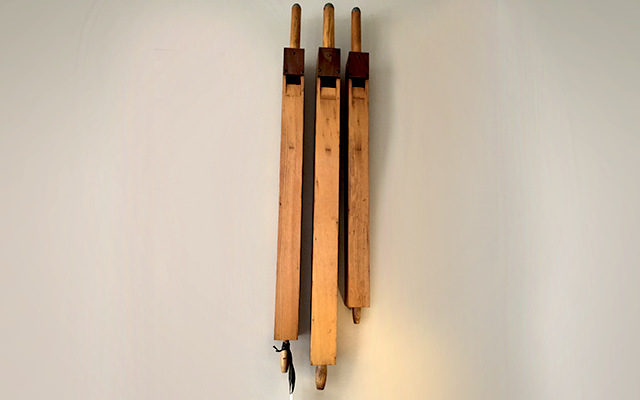
Music to your eyes.
Last spring our plumber’s wife called to ask if we had any interest in hundreds of old organ pipes she had rescued from a landfill in Orwell, VT.
As usual, I was just sitting around waiting for an opportunity to acquire hundreds of organ pipes that we did not have room to store and no earthly idea what to do with. But we are always seeking the unusual found object we can repurpose.
Our curiosity piqued, we drove to Orwell, about 30 minutes from our Vermont shop. We were so amazed at the workmanship, beautiful wood and the sound many of the pipes made that we came back with hundreds of them in need of serious cleaning and waxing.
I asked our friend how all these pipes found their way to her. She said she received a desperate call from a friend that an elderly neighbor had passed away and left a couple of barns full of organs and organ pipes. His estate had sold the property and the buyers wanted it all GONE. So up came the dumpsters and off it all went to a landfill except for the bit that she rescued. It’s amazing to us that these relics of worship and this gentleman’s lifelong collection could be so cavalierly disposed of. But once again, ours is not to judge.
As soon as I saw them I knew they would make unusual and provocative objects to gang together and hang on a wall. The pipes run in size from a few inches to 10 feet long. Most are crafted from hardwood but some are lead.
Honest Mistakes and Audacious Lies
As I stated in my blog post of July 11, 2016, we are not antique dealers. Yes, we acquire antiques and objects from Europe, Canada and the Americas, but unlike many antique dealers we rarely offer any claims of an object’s pedigree.
If a guest in either of our Found Objects locations wants the story behind an object, we tell him or her where we acquired it and what we think it is.
Once in a while we’ll pass along the story that the dealer we purchased it from offered us. But even this can lead to trouble.
A case in point: we offered for sale a set of three primitive folk art rag dolls in our Vermont location. On the tag we repeated what the dealer had told us about the dolls: “Early 20th Century Dolls made by Nancy Henderson in North Carolina.” The dolls, professionally framed and mounted behind glass, were priced $260 for all three.
A dealer came in and purchased them from us, intending to resell. A few days after he bought them, he called to inform us that a fellow dealer, who also happened to make reproduction folk art dolls and was apparently an expert on the topic, had declared these dolls to be recent, high quality reproductions. We graciously informed him that we had not warranted the dolls as anything more than folk art dolls – and the price certainly didn’t reflect rare treasures -- but because we included information on the tags without provenance, we were embarrassed.
What were we to do? I know the dealer thought he was getting a deal because he thought the folk art dolls were worth far more than we were selling them for. He believed they must be very valuable. His doll-expert friend had dashed his hopes of making a killing so he wanted his money back.
It is customary in antique and vintage shops that once you buy an item you own it and there are no returns or refunds. The Latin term, caveat emptor --buyer beware-- applies here. The Found Objects receipt states: “Vintage and antique items are sold ‘as is’ and are not refundable.”
BUT, because of our error we allowed him to return the dolls for a refund rather than store credit. The dolls, incidentally, are back on the sales floor, their tags no longer listing their alleged age. We don’t know if the dealer’s doll-making friend was correct or not in her assessment of these folk art pieces. For all we know, they could be authentic after all. But we’re not in a position to say either way. We’ll leave that to the experts – or proto-experts. We don’t want to ever, knowingly, misrepresent anything to anyone. It’s bad business and bad karma.
Which brings me to the real life fable of the Hobbs brothers. My sense is you haven’t heard this deliciously nasty tale of greed and avarice, because few of us find ourselves in this rarified world of uber-expensive antiques.
The Hobbs brothers, John and Carlton, were royalty among international antique dealers. John, in London, and Carlton, in New York City, sold exquisitely rare antiques in the five- and six-figure range. High-end interior designers such as Bunny Williams and Peter Marino enlisted the brothers to acquire investment-quality antiques for their clients, which included the likes of Oscar de la Renta, Valentino and David H. Koch.
However, evidence began to mount that the two brothers had been using a furniture restorer named Dennis Buggins to fabricate “period antiques” convincing enough to even fool the experts at Sotheby’s and Christie’s.
Please see the New York Times links below to see how this drama came together and collapsed like an Ikea bookcase. Besides being deliciously dishy, the tale provides an object lesson in how difficult it is – even for experts -- to say what truly is and isn’t an antique, especially when it comes to period antiques.
My advice to everyone is caveat emptor, regardless of the dollar amount you spend, what you’re buying, and where you’re getting it from.
The New York Times: The Feud and the Fakes Article
The New York Times: Furniture Restorer’s Allegations of Deception Shake Antiques Trade Article

Salesman’s Sample c. 1950 (?)
Anyone who grew up in Kansas, Nebraska, Colorado, the Dakotas, Oklahoma, Texas, or New Mexico was never far from a windmill. Without them there could not have been much settlement of the arid high plains.
Their eight-foot diameter spinning blades brought the promise of water to countless farms, and the mills stood as ubiquitous reminders of how fragile life was for each of those farmsteads.
Over six million windmills were installed in the United States between 1850 and 1970,* nearly all of them to provide water for livestock and farm use. A large majority of these windmills were manufactured by the Aermotor Windmill Company.
Salesman’s samples like the one we have were used to sell windmills to farmers and ranchers all over the States.
The company was founded in Chicago by Mr. La Verne Noyes in 1888. He manufactured dictionary stands and farm equipment, but when he hired Thomas O. Perry to develop a grain binder (whatever that is) he quickly recognized that Mr. Perry’s research on wind wheels had far more potential. From 1888 on he devoted the rest of his life to the Aermotor Windmill Company and philanthropy.
Now on to the acquisition of our salesman’s sample:
A few years ago we drove down to the state of “Justice, Wisdom and Moderation” to attend a large gathering of antique dealers.
We arrived early, before the event began but after the dealers had set up. So we went in a side door and began our search for things we could not live without.
Because we were a bit ahead of the pack there were some unattended booths. No worries for us because much of the offerings didn’t interest us. Here was a vast warren of either common stuff or very expensive good stuff stacked everywhere.
We wandered and wandered and then spied, sitting on a chest of drawers in an unattended booth, the miniature, salesman’s sample windmill pictured here. We waited and waited but no one showed up. So I took the sample and left my card on the chest of drawers and off we went.
After we had picked the show to exhaustion we returned to the booth. The gentleman had not even missed the windmill so he was doubly surprised that we returned to pay for it.
Since then we have acquired another vintage salesman’s windmill, and a friend gave me an exact, not-so-vintage replica of one, but made in China. Really.
*Darrell Dodge, “Illustrated History of Wind Power Development”
This is another example of a World War II era toy.
It was made entirely by hand with very little metal; the body of the caboose is constructed from a cheese box. It is not a fragment but complete, with wood wheels and metal guardrails on both platforms. (I wrote about these in my earlier “Buddy L Fire Truck Fragment” entry.)
It was carefully crafted for someone’s loved one. When we found it, we were told it was the only remaining piece of an entire handmade train set. Can you imagine the time and care it took to craft an entire train of found materials?
If we had found the entire train I would have been in choo-choo heaven. Still, I’m very grateful just to have the caboose.
This toy has its original red paint and is a fairly accurate representation of a caboose. Charming for those of us who love trains and toys.
We currently have a number of WWII-era toys of made from cheese boxes and metal spice tins. We even have a series of earlier toy airplanes that I hope to feature in a later blog. The rarest of these toy planes is a complete seaplane, not a fragment.
Please send us photos of the toys you love and collect.
By the way, as I write this I am on Amtrak train #66 heading north. All aboard!

As you read our blog posts please keep in mind that we are neophyte, junkyard boys, if you will, and not antique or fine art appraisers.
We purchase with our eye. If an object has presence, value and appropriate scale we purchase it, even if we don’t necessarily know what it is. In fact, it’s not uncommon for customers to fill us in about pieces we have on the floor: what something was used for or what it’s called. The learning never ends.
Much of what we acquire is antique, 100+ years; or vintage, under 100 years old. Only rarely do we acquire investment objects with a verifiable provenance. When folks come into one of our shops they like to know a piece’s story. We share with them where we acquired it and what we think it is. We warrant nothing to be more than it appears and we tell folks to “buy with the eye” and with the object’s usefulness in mind, and not to purchase it for any other reason.
Sometimes a seller will share with us the romantic story behind a piece that catches our eye. We’ve learned to take these stories with a grain of salt unless it can be proven. We’re happy to pass the tale along to our own customers, but always with the caveat that it could be total bullsh_t. We have no way of verifying – no provenance. The story is never reflected in the price of the piece.
Because there’s a lot of confusion regarding the nature of authenticity, I offer the following definition of the term provenance:
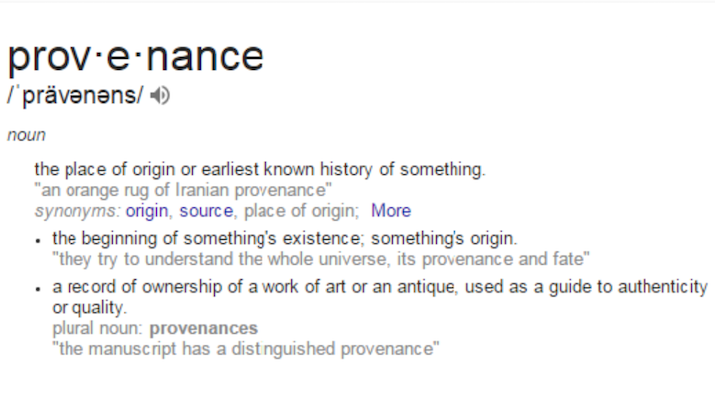
The bastard cousin of provenance is the “Certificate of Authenticity” (COA) which is often a meaningless attempt to make something appear more valuable than it actually is. In truth it does not increase the value of anything. It is my understanding that a COA is laughed at in the fine art community and discarded out of hand.
Provenance, however, is a different story. Here’s an example from our experience:
Early in our career we had the honor of procuring, with provenance, a Pierre-August Renoir lithograph, Children Playing Ball, with Renoir’s thumb print on the bottom right corner.
David Steadman of the Chrysler Museum authenticated the letter of provenance and verified that the work was an original Renoir. (The Chrysler Museum owns a companion.) The letter of provenance provided an unbroken chain documenting each time the artwork was sold and to whom it went.
This lithograph was originally purchased from Renior by a member of the Romanov family. It also came with two magnificent frames owned by the Romanovs; one for their Moscow residence and one for their Paris residence.
David Steadman was very gracious to us; he took the time to share with us a bit of the basics regarding fine art and the value of a verifiable provenance.
Please see my earlier blog regarding Julia and Paul Child’s dining tables and chairs.
Sphere Enigma
Once again I’m beginning a blog that starts in one place and moves much like Mark Twain’s miner in Nevada who never finished a story because one thing reminded him of another so he kept starting a new story in the middle of the last story. So here we go:
We were heading to the South of France to find reclaimed stone floors and, like so many Americans, we could not visit France without spending a few days in the City of Light. We’ve had the privilege of traveling there many times and, contrary to popular myth, we have found the people of France charming, gracious and helpful.
We were very fortunate to find ourselves in Paris during the Biennale des Antiquaires. And so we decided to spend one of our days at the show.
Off we went like Jethro and Elly May to a Beverly Hills bash; it didn’t take us but a moment to realize we were interlopers. Whenever we find ourselves in such situations, we don’t waste anyone’s time and we don’t flee; we educate our eye and keep out of people’s way.
But where Anglos fear to tread, I had to venture.
At the entrance to a booth of marvelous European period furniture were two 24-inch, magical, marble spheres. They spoke to me. The booth did not have any visitors, so I approached the proprietor.
I made the unforgivable transgression of asking the gentleman about the spheres. He informed me in the most arrogant tone that they were 18th century and cost 2000 Euros.
I coolly asked him if they had provenance. He harrumphed and spun around to show me his derriere. I took that as a non.
The question before us is how do you determine the age of marble spheres if you do not have provenance? It is impossible. All stone is old, for crying out loud.
In two of my upcoming blogs I’ll describe at length the importance of provenance in authenticating an object’s age and value, and the philosophy of caveat emptor as a guide to purchasing, so I won’t go into it here.
Now on to more about stone spheres.
When Columbus arrived in the Americas he failed to discover something that was not found until 1936: hundreds of perfectly round stone spheres. These orbs range in size from 10 inches to about 8 ½ feet, and can weigh up to 15 tons.
Fashioning these spheres requires very technical geometric skills and sophisticated tools. They’ve been found only in Costa Rica and Bosnia. In neither location is there any reference to them in folklore or oral history. How they came to be is purely a matter of conjecture, but that is not part of Mark Twain’s -- I mean my -- ramblings.
As a natural geological phenomenon, stone formations that are not perfectly spherical, but round enough to inspire a sensitive soul to create marble spheres, may be found in China and France.
These we do not have.
But we do have these:
Marvelous pumice spheres from the rivers of the Philippines. Tumbled by the rivers into a spherical shape but made perfectly round by the hands of the Philippine craftspeople. I was so thrilled to find spheres so lovely and affordable. Yes, they are porous enough to grow mossy in your garden.
14”: $110.00
12”: $ 95.00
Small: $ 65.00
Disclosure: I am addicted to urns. Sterling, silver plate, iron, whatever!
We have them from 3” to 48”, antique and vintage. (New iron urns are virtually all from China and not on my picking list. Does that mean we don’t have any urns from China? No, probably not; it can be very difficult to determine country of origin, not to mention the age, of a rusted/painted iron urn.)
Now on to our urn find: In 1901 the city of Buffalo, NY hosted the Pan-American Exposition. For the occasion Tiffany & Co. created small (4.5”x4”) Georgian, silver plate commemorative urns.* These urns bear the “beaver” mark and number “0280.“
While searching among 10,000 square feet of cultural detritus in Williamsburg, VA, I spotted these urns at the last minute. Their scale is unusual and the condition of the silver plating is average to above average.
Really; when was the last time you saw urns of this scale and charm? If you have one please email me so we can exchange urn photos. These two objets are now on our floor in Virginia Beach waiting for another urn addict to come in!
Summary: Traditional form, small scale and Tiffany & Co quality.
* “The Beaver Mark” by Mike Burrows, The Finial, June/July 2003, page 1.

Mural by Troy Summerell, OnieTonie
An article about the birth of the new ViBe Creative District where we have our interior design practice, Details, and antiques shop, Found Objects
On Sunday, May 15, 2016, the summer issue of Distinction magazine was released. Distinction is a magazine of “culture, dining & style” that’s sold in the Virginia Beach/Norfolk, Virginia area. The issue contained a wonderful, enthusiastic article about Virginia Beach’s ViBe Creative District, a new and excitingly artsy area blossoming out of a formerly blighted neighborhood.
Croc’s 19th Street Bistro and Details Interior Design were the first creative businesses to colonize the ‘hood, 20+ years ago and 16 years ago, respectively, when it was still a seedy place to be. And because we’re seen as pioneers here, Laura Habr of Croc’s and I seem to have become, in effect, the spokespersons for the ViBe.
And believe you, me, we’re grateful for the publicity that our nascent arts district received in the Distinction article. Of course no article could capture or even touch on every aspect of the story. Space just doesn’t allow. At Distinction, as with all independent publications, the editorial board and the publisher determine the scope, tone and content of the articles published. No one has any editorial control other than these folks.
Would I have liked the section, “Some Other ViBe Destinations,” to include all of the businesses that have been active in the ViBe? Absolutely! But since that wasn’t possible, I want to list all the businesses that make the ViBe vibrant. (If I’ve omitted anyone, please let me know so I can update the list!)
My heartfelt gratitude goes out to everyone who is working to make their ViBe business a success and to bring all of us together.
Image credit: Distinction Magazine
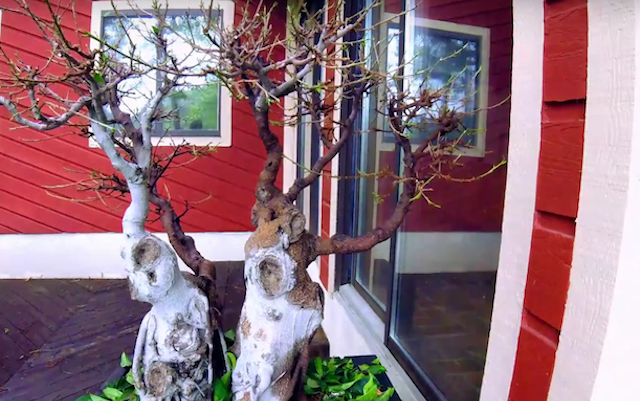
A beautiful San Francisco ficus planted between 1890 and 1910.
Around 2006 we received a visit to our studio from a gentleman from Ohio asking if we would give our assessment of a home he was purchasing in an Oceanfront neighborhood in Virginia Beach called Croatan.
We met the Realtor there and a GC and a structural engineer and found the home to be not just offensive to the eye but shockingly structurally unsound.
I gave him a call and explained our opinion of the property. He was very grateful for our time and asked us to send him an invoice. We explained that we were not qualified to provide home inspections. All we could do was offer our personal assessment; therefore, we could not invoice him for our time.
While he was in our studio he commented on the trees we had growing there. We told him we felt commercial and residential environments, nearly universally, benefitted from live plants.
Little did we know he was a serious collector of bonsai trees. Serious collector means he had scores of specimens that were hundreds of years old.
One day an old pickup truck pulled into our parking lot. The gentleman from Ohio got out of the truck and came into the studio and announced he had a gift for us. By the way, he wanted to know if we had a cart on casters.
A cart with casters we had!
So out he went and came in the door with the one tropical bonsai specimen he owned, a San Francisco ficus planted between 1890 and 1910. How did he know how old it was? I can’t begin to answer this question.
We were dumbfounded by the presence of this spectacular specimen. He knew we would love her and care for her until she outlived us and that we would make arrangements to pass her along to another worthy soul. An amazing gift with an amazing responsibility to go with it.
We told him we would have no idea how to care for her. He said it’s simple: water her on Sunday and Thursday. Every two years find a local bonsai lover to assist with repotting, pruning, etc. and keep her in bright, filtered light. And he set off in his old pickup truck.
After a good deal of searching we found our local bonsai lover: Jay Prock. Jay is a lovely young man of great intelligence, strength, humanity, and he loves bonsai. He and his lovely wife, Christina, take the girl off to “summer camp” every spring and give her the care she deserves.
This year she required a serious defoliating, pruning, repotting and some shaping.
Please see Jay’s video of the bonsai before and during the defoliation. In early autumn Jay will report back, with photos of the tree’s progress.

Mural by Troy Summerell, OnieTonie
I would like to begin this post by thanking the folks at Distinction magazine for their fine work on the article, “It Takes Vision to Create a ViBe.”
I would especially like to thank Mike Hixenbaugh, Eric Lusher, Hyunsoo Léo Kim and EJ Toudt for all the care they took to present the ViBe Creative District to our neighbors.
I know there are many people unhappy with the article. But there are also a great many members of the District who are thrilled with it. Thanks, guys.
We received a call from Distinction the other day to let us know they had produced a video companion to the ViBe article. Wow! We did not expect that. Anyway please see the link below.
Best,
Charles
Image credit: Distinction Magazine
A recurring theme in our blog posts is our love of folk art and particularly folk art toys.
This is an especially captivating steamroller we acquired from the private collection of a true Renaissance man, antique collector, photographer and painter: Durwood Zedd.
It is a privilege to know Durwood, his many talents and his gentle ways. Please Google Durwood and introduce yourself to his creative talents.
Now back to the steamroller: circa 1920, made from hardwood with a few metal parts. It’s 14 inches long, 7 inches wide, and 11 inches tall. This example of a handmade/polychrome toy is a marvel of craftsmanship, form, color, and scale. We are proud to have it in Found Objects, Virginia Beach.
Oh, it is for sale. But like I say of many of the items in our collection: “This sh_t ain’t cheap.”
As long as we’ve been collecting found objects I’ve been captivated by tobacco baskets.
What, you might ask, are these? They are usually 36-inch square, oak, slatted baskets used for transporting tobacco from the drying sheds to the tobacco market. They were in common use until about 1980; some folks have told me this type of basket is still used in Maryland tobacco markets.
We know a gentleman named Charles, from western Virginia, who finds a few at a time in barns and sheds of his family’s circle of friends. When his tobacco baskets are in fairly good shape we purchase them. But what a filthy mess they are; the baskets have been lying neglected for the best part of 35 years.
We clean off the dirt, cobwebs, and leaves that coat them. Then I disinfect them with a vinegar and water solution. No one minds a little dirt, but chicken sh_t is a deal-breaker for some people. I then stand them on end to dry before applying a coat of light brown Briwax. After the wax has dried I use one of Papa Harry’s fabulous old brushes to burnish the wax into a beautiful sheen. (Papa Harry is not a brand but my husband’s late grandfather.) The Briwax coaxes out the tobacco basket’s color and stenciling.
Once we found two 18-inch square tobacco baskets with similar market stenciling. We had no idea why the size was significantly smaller than the others but we loved the smaller scale. I prepared them the same as their larger cousins and hung them in our location in Vermont.
I was in the store when a young woman came in and announced these two smaller baskets were from a Connecticut pipe tobacco market. I looked at her, shrugged, and gave her my best “if you say so” look. She responded, “I know because my family used to grow pipe tobacco I still live on our family farm.” So, as with all things in my world, I am the dumbest guy in the room. I thanked her for her contribution; we relabeled the baskets: Connecticut pipe tobacco baskets. Subsequently, we found a tobacco basket that was 18 by 30 inches and can only surmise it is also a Connecticut pipe tobacco basket. None of these baskets stay long in either of our locations, but the smaller ones fly out.
We currently have two smaller Connecticut pipe tobacco baskets and a couple of North Carolina tobacco baskets in our collection. We are always on the hunt for more; so if you know of someone who has them please give us and them a shout.
Brent and I were in Atlanta for the Scott Antique Market.
In those days you could get there on Wednesday morning and watch the outside dealers unpack and set up to get the best stuff*, and did we find some great stuff: a large round Empire table with a zinc top; half the blades of an eight-foot windmill (placed in a commission in Parker, Colorado); a complete four-foot windmill that we had powder coated a deep tomato red and placed in the same Colorado commission. (Do ya think I have an issue with tilting at windmills? Duh!) Which brings me inexplicably to the Brazilian water jars.
Whoops, not yet. At Scott’s you used to be able to go into the large inside hall early, while the vendors were setting up. What big fun and you got to see the best stuff before the show opened. **
One more windmill tale. Prior to the show opening, sitting on a table in an unmanned booth, was a 12-inch salesman’s sample of an Aerator Windmill. I snatched (love that word!) it up and walked off with it, telling the folks in the next booth that I had taken it. I gave them our card and told them we would return when the show opened to pay the rightful booth-holder for it. I was and am so pleased with our miniature windmill(s). I have a collection of three (only two are vintage) sitting on a credenza in my office. When we went back and paid for the windmill, the seller said he hadn’t even missed it. We all had a big laugh and off we went.
And we met the late Rosenbergs, a genteel couple in their mid-‘80s. Kind, gentle, and knowledgeable about all things regarding “premier peoples.”*** We never knew the Rosenbergs’ first names even though we purchased many gorgeous objects from them over the years. Our memories of this lovely couple are so much more enriching than any of the objects we acquired from them. (We’ll feature a few of these lovely things in future posts.)
Where was I? Oh yes the Brazilian water jars. While in the Atlanta Market we met a lovely woman who told us of an American who lived in the Brazilian highlands and had a warehouse in Atlanta. She gave us the address (kinda) and off we went.
What she did not tell us was that his warehouse was in an obscure area of industrial Atlanta that flummoxed Mapquest. We wandered around in our not small Sprinter for some time and finally located him. Needless to say he did not get much street/walk-in traffic. He was eager to make a “deal” (I loathe that word) so he could pay the IRS.
The place was two cavernous rooms. Furniture filled most of the floor space but one entire wall held shelves from floor to ceiling with his collection of water jars.
He moved to Brazil in the mid ‘80s and fell in love with the ceramic water jars made for domestic use. Not at all dissimilar to the wooden water buckets used here in the US of A prior to the blessings of municipal plumbing.
Only a few were more than 18 inches tall, some with flat bottoms for use on hard floors, some with rounded bottoms to sit on soft floors. All very beautiful each in its own right. We spent hours sorting though them to select the most striking glazes, with the fewest chips and the least cracks. Some had such radiant glazes that we overlooked the chipped rims. After all, these vessels had seen years of daily use.
We currently have a have a dozen or so of his jars in our collection. All are precious; none are cheap.
*by “stuff,” I mean, of course, “sh_t.”
**Alas, we can no longer do this by order of the fire marshal -- clearly a person of very large importance needing to be even more important. Really, Mr. Big Importance, go put out a fire or something of the fire persuasion; this flame has business to do.
***The French Canadian term for the indigenous people of North America. So much more gracious and respectful than “American Indian” or “Native American.”
We found this little gem (about 7-inches tall) on the Northern Neck of Virginia.
I cannot imagine it was mass produced, but who can say? Every detail is painstakingly executed like a finely tailored garment. I imagine it might have been a student project for a fine arts program.
If anyone knows anything about this coat of mail please email me.

Sometimes the greatest found objects hide in plain sight, and the greatest artwork isn’t the painting…but the frame.
This cart is a perfect example. It was found at auction by our observant friends George and Christi in Smithfield, VA.
While everyone else at the welding shop auction was bidding on the tools, George and Christi fixated on the cart the tools were sitting on. Welders had no interest, but George and Christi knew the cart had great potential out of the workshop and in the house. They bought it, cleaned it up, added the reclaimed wood top, and asked us what we thought of it.
It was a no brainer. We had to have it to sell at Found Objects.
Not the end of the story.
Our passion for old industrial carts is shared with many of our friends, including photographer Chris Crumley. He borrows several of our carts for photo props. This photo is courtesy of Chris. Check out his website and see his fantastic work: www.Chriscrumley.com.

Buddy L fire truck fragment
Another Disclosure: I am addicted to folk art toys, stamped metal trucks and woodtrucks. Oh yes, and did I mention planes, trains and boats? Addicted to these, too.
We were in Fredericksburg, VA on business. Whenever we travel we always have our eyes out for a “find.” There is so much bad stuff out there it is like the proverbial needle in a haystack trying to find a “find.” This “find” is a fragment of a fire truck that is 100% wood: body, wheels, axles, head lamps. The paint is original.
During World War II metal was rationed or so expensive that toy manufacturers were forced to use wood. Buddy L is one of those companies, founded in 1920 by Fred Lundahl in East Moline, IL.If a toy or an item of folk art is missing a part we call the item a fragment. This way folks know that it is not complete.
We’re frequently asked where we find things. The answer is almost always in junk shops or antique places that are too often nothing more than overpriced junk stores. The “find” takes a lot of hunting and a bit of luck. I say even a blind squirrel can find an acorn in the forest once in a while. This trip we found not one but two wood trucks! Woo-hoo! I was in heaven…and truth be told, I almost missed them both. My husband, Steven, found one, and my good friend, Dee, spotted the other. This time I was the blind squirrel. Along with the Buddy L fire truck we have a large wood moving van, which I’ll tell you about another time.

We are very pleased to have been featured in Distinction magazine.
An article featuring the design work we did for one of our clients in Virginia Beach
If you have any comments please contact us at info@detailsinteriordesign.com.

Perfect plinths for your pampered plants and objects.
Our quest to provide antique building materials for a private residence in the States took us to France. Prior to the trip we’d spent weeks researching stone and acquiring dozens of samples. We decided on a reclaimed stone called Pierre de Bourgogne, from a reclamation yard near Aix-en-Provence.
When we arrived at the yard we met Hervé, a young man in his early 30s. Behind him and off to the side stood a very senior man who stood like a stone himself, with no emotion or eye contact. We were not introduced.
Hervé didn’t speak English, we didn’t speak French, and the older gentleman seemed unable to speak at all. We talked through translators. It was very businesslike.
I took the tile sample Hervé had sent us out of my pack and began comparing it to the crates of stone to insure their patina matched. A word about the sample: It was divine. It was cut from stone used in the floor of a home, stable, warehouse, or government building; polished smooth by 100+ years of scrubbing and foot traffic; like no other surface you have ever felt or seen. I went from crate to crate and it was apparent that much of the stone in the crates had come from exterior locations and lacked the rich patina we’d traveled four-thousand miles for.
As soon as I pulled the tile sample out of my pack the older gentleman came alive, studying me with great interest. He needed no translator to read my body language. I was not happy. After I inspected about ten crates he strode over with great authority and thrust his hand out to inspect my sample. He took the tile, rubbed the surface, burst into laughter and said “cette est magnifique!” We all laughed in shared appreciation for the beautiful stone. And we’d won the man’s respect by demonstrating we knew how to discern good stone from truly great stone. He decided we were not ugly Americans. The man. Hervé’s father, went by the nickname Lull. He’d begun reclaiming building materials just after World War II. It was his life’s work and it was clear he loved it.
He showed us his entire operation in great detail, presenting his collection of exquisite antique Pierre de Bourgogne, antique Barr, concrete floor tiles, reclaimed Jerusalem limestone and of course wonderful reclaimed 18th-19th century terra cotta floor tiles.
By the end of the morning Lull promised that he would fill our crates with majority of interior stone. Lull would not allow us give him the predetermined deposit until he took us to lunch at his favorite restaurant -- an hour’s drive past endless fields of sunflowers and intoxicating lavender. Four hours later we were still at lunch, drinking his private stock of Armagnac.
When the containers arrived in Virginia it was apparent Lull had lovingly hand selected every single stone; virtually all had the beautiful patina that spoke to us across time and cultures. Lull has since passed away, but I have many more Lull stories for another blog.
We have a limited number of French, 19th Century terra cotta floor tiles from Lull’s collection. We use these marvelous reclaimed tiles as plinths for pampered plants and objets d’art. I clean and wax them then put tabs on the bottom so they don’t scratch surfaces.
+/- 7”x7”, 13”x6.5” and 6”x6” 19
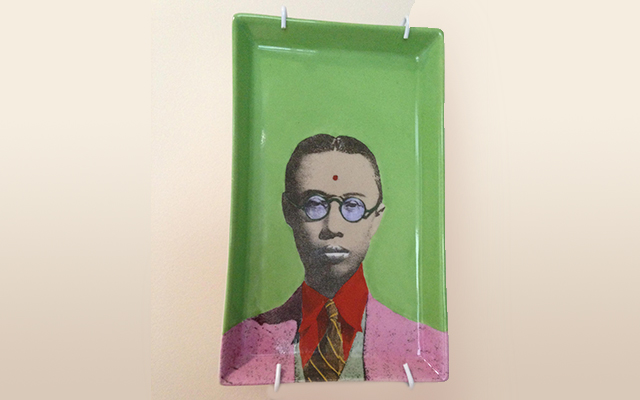
We were in Los Angles for an Urban Land Institute meeting and found ourselves in Chinatown.
We were fascinated by the pop art portrait of Henry Pu Yi, the last of the Manchu Emperors, by the French artist Fabienne Jouvin. We purchased the three colorways.
Subsequently, we were in an Asian antique shop elsewhere. In the back room, high on a shelf and covered in dust was the white shungite bust of Chairman Mao.
How could we resist High Kitsch Mao? When we run into iconic representations of historical figures it’s hard to pass them up. So we don’t.
It is not our place to judge the contributions of these two men but it’s hard not to miss the irony of these two found objects.




Julia and Paul Child's Dining Chairs with provenance.
The story of how we acquired Julia and Paul Child’s dining tables and four chairs begins with a 1907 Steinway, Model M piano.
We’ll save the Steinway acquisition story for a different blog; however, as with nearly all things we do, there is a vast interconnection between events.
We won the Steinway at the Brandon, Vermont town auction. It had been owned by the same family since 1907 and was badly in need of a major restoration. In our quest for a person to restore the piano we were referred to a book antiquarian in Castleton, VT, Ms. Patricia McWilliams.
We called Ms. McWilliams, who put us in touch with her husband, Doyle Lane. Doyle, a quietly brilliant man for whom piano restoring was just one of a long list of skills, didn’t flinch at the sad condition of the Steinway. But this would take some time. During the many ensuing months of the restoration we established a relationship beyond the Steinway.
Halfway into his meticulous work Doyle called me to say he would not be able to finish because he’d been diagnosed with a fast moving, terminal cancer. As you can imagine it was an intense, emotional call.
Doyle spoke of how grateful he was that the old Steinway brought us our friendship, and recounted that his love of pianos began decades ago when he restored his first one. He was truly sorry he wouldn’t be able to finish the Steinway. I replied that it was too soon to give up. I told him that if he could not beat the cancer, I would like our Steinway to be his last restoration. Doyle’s somber tone brightened as he agreed to complete the restoration or find an apprentice he could mentor to do so. As it turned out Doyle passed away before the piano was completed but Ms. McWilliams shared with me that from that telephone call until his death, Doyle lived and breathed the completion of our piano. I will share the details of his herculean restoration effort when I tell the piano’s story.
Shortly after Doyle passed away, Ms. McWilliams called again to thank me for the great gift I had given to her and Doyle. She said our piano gave Doyle tremendous meaning and purpose during his final months; she was very touched that I asked Doyle to stay the course. Now it was time for her to clear out some things from Doyle’s cavernous warehouse. She reminded me that Julia Child was her aunt, and she offered Julia and Paul’s chairs and tables to us. After we acquired them we had each piece lovingly restored and offered for sale in Found Objects.

I am proud to say: "Welcome."
Recently, I completed my contribution to our new website; I know the incredible team at Cranium 21 is pleased I finally did it. This means we can now share what we hope is an inspirational event.
The team at Cranium 21 have spent a good deal of time creating a website that is intuitive, simple to navigate, informative and refreshing.
The main categories have been designed to focus on our approach to the practice of interior design and those types of commissions we love creating: Multi Family, Residential, Adaptive Reuse, and Contract Commissions.
We have also integrated into the website our retail store: Found Objects. Found Objects is our curated collection of, you guessed it, found objects. Brent and I wander far and wide gathering antique furniture/accessories, textiles, industrial objects, architectural fragments and about anything else that we feel has a presence, is useful and a good value.
So begin clicking. Let us know how we did and what we can do to improve your experience.
Best,
Charles Powell